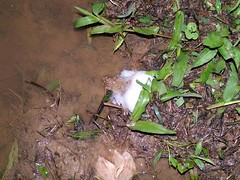Team:Glasgow/Ranaspumin2
From 2011.igem.org
(Difference between revisions)
| Line 7: | Line 7: | ||
Ranaspumin 2 is one of six proteins used by the tungara frog (<i>Engystomops pustulosus</i>, found in Central and South America) to form protein foam nests in which it deposits its eggs. Protein foams are relatively rare in biology, and in this case offer a biocompatible solution to incubation and protection from mechanical destruction, as well as anti-microbial properties. | Ranaspumin 2 is one of six proteins used by the tungara frog (<i>Engystomops pustulosus</i>, found in Central and South America) to form protein foam nests in which it deposits its eggs. Protein foams are relatively rare in biology, and in this case offer a biocompatible solution to incubation and protection from mechanical destruction, as well as anti-microbial properties. | ||
</p> | </p> | ||
| - | < | + | <table> |
| - | <img src="http://farm7.static.flickr.com/6169/6166704517_2646892173_m.jpg" width="300" height="250"> | + | <tr> |
| + | <tb> | ||
| + | <img src="http://farm7.static.flickr.com/6169/6166704517_2646892173_m.jpg" width="300" height="250"/> | ||
<font size="1" color="grey | <font size="1" color="grey | ||
<i>E. pustulosus</i> forming its foam nest<sup>1</sup></font> | <i>E. pustulosus</i> forming its foam nest<sup>1</sup></font> | ||
| - | </ | + | </tb> |
| - | < | + | <tb> |
| - | <img src="http://farm7.static.flickr.com/6169/6166704517_2646892173_m.jpg" width="300" height="250"> | + | <img src="http://farm7.static.flickr.com/6169/6166704517_2646892173_m.jpg" width="300" height="250"/> |
<font size="1" color="grey" | <font size="1" color="grey" | ||
A Tungara frog foam nest from Trinidad<sup>1</sup></font> | A Tungara frog foam nest from Trinidad<sup>1</sup></font> | ||
| - | </ | + | </tb> </tr> |
| + | </table> | ||
Revision as of 19:48, 20 September 2011

Ranaspumin2
Ranaspumin 2 is one of six proteins used by the tungara frog (Engystomops pustulosus, found in Central and South America) to form protein foam nests in which it deposits its eggs. Protein foams are relatively rare in biology, and in this case offer a biocompatible solution to incubation and protection from mechanical destruction, as well as anti-microbial properties.
 "
"

 1
1